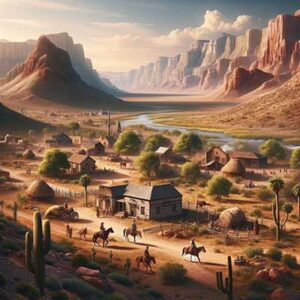Pre 1899 Did You Know Henderson
Henderson's Early Years: The Foundations
Before 1899, Henderson was a landscape marked by its natural beauty and untamed wilderness. This era set the stage for the city’s future development. The area, now known as Henderson, was rich in resources, drawing the attention of pioneers and settlers.
In the mid-1800s, explorers first ventured into this region. They found a land ripe for opportunity. The presence of the Colorado River nearby was a key attraction. It offered a vital water source in the arid Nevada landscape. This period saw the first trails blazed through the region. Settlers were drawn to the area’s potential for agriculture. The fertile soil along the riverbanks was ideal for farming. Early crops included corn, beans, and cotton. These initial farming efforts were the precursors to Henderson’s agricultural development.
The Influence of Native American Tribes
The region was home to Native American tribes long before settlers arrived. Their presence shaped the area’s history. Tribes like the Paiutes used the land sustainably, living in harmony with nature.
Their knowledge of the land was invaluable. Early settlers often relied on this wisdom for survival. The Paiutes’ techniques in farming and resource management were particularly noteworthy. Their influence is a vital part of Henderson’s early history.

1899 and Before Did You Know...
Ancient Inhabitants (Before 1000 AD): The area where Henderson now lies was inhabited by Native American tribes thousands of years ago, with archaeological evidence dating back to before 1000.
Spanish Exploration (1776): In 1776, Spanish explorers traversed the region near modern-day Henderson, marking one of the earliest European explorations of the area.
Mormon Settlement (1855): In 1855, Mormon settlers established a mission in the Las Vegas Valley, near what is now Henderson, as part of their expansion into the Southwest.
Transcontinental Railroad (1869): The completion of the transcontinental railroad in 1869 brought significant changes to the region, facilitating easier access and economic development.
Nevada Mining Boom (1859-1880s): The Nevada Silver Rush started in 1859, led to a mining boom, with prospectors exploring regions near Henderson in search of precious minerals.
Paiute Tribes (Pre-19th Century): The Paiute tribes had a long-standing presence in the region around Henderson.
Ranching Era (Late 19th Century): Before urban development, the Henderson area in the late 19th century was primarily used for ranching, contributing to Nevada’s agricultural history.
Natural Springs (19th Century): Throughout the 19th century, natural springs in the region were crucial for early settlers and travelers, serving as vital water sources for communities.
The Old Spanish Trail (1829): The historic Old Spanish Trail, established in 1829, passed through the region, becoming a significant trade route influencing early commerce.
John C. Frémont’s Exploration (1844): In 1844, explorer John C. Frémont passed through the region, documenting its geography and resources, which later influenced settlement patterns.
First Post Office (1851): The first post office in the Las Vegas Valley was established in 1851, a significant step in the region’s development towards Henderson later on to becoming a settled community.
Early Settlers’ Arrival (1830s): The first non-native settlers, predominantly traders and missionaries, began arriving in the Las Vegas Valley area in the 1830s.
Mexican-American War Impact (1848): The Treaty of Guadalupe Hidalgo in 1848, ending the Mexican-American War, led to the Las Vegas Valley becoming a part of the United States, influencing its subsequent development.
Native American Reservations (Early 19th Century): In the early 19th century, several Native American reservations were established in Nevada, preserving the cultural heritage of tribes native to the Henderson area.
First Schools (Late 19th Century): The first schools in the Las Vegas Valley area, near Henderson, were established in the late 19th century, marking the beginning of formal education in the region.
Agricultural Development (Mid-19th Century): In the mid-19th century, the areas surrounding what is now Henderson began to develop agriculturally, particularly in the cultivation of crops like corn and wheat, due to the fertile land and availability of water.
Pioneering Settlements (Early 19th Century): Early 19th-century pioneer settlements near the Henderson area laid the foundations for the city’s development, with settlers attracted to the region for its natural resources.
Early Ranching Ventures (19th Century): In the 19th century, the areas around Henderson saw the establishment of several ranches, utilizing the vast open lands for cattle and sheep grazing.
Mormon Influence (1850s): The Mormon settlers in the 1850s had a significant impact on the Las Vegas Valley, close to Henderson, particularly in establishing agricultural practices and community organization.
Mining Activities (19th Century): While not as famous as other Nevada locations, the areas around Henderson experienced some mining activities in the 19th century, contributing to the local economy and settlement patterns.
The Impact of Mining and Railroads
The discovery of minerals in the surrounding areas led to a mining boom. This period marked the beginning of industrial activity near Henderson. Silver and lead mines attracted workers, setting the stage for community growth.
The arrival of railroads was a turning point. It connected the region to larger markets. This development was crucial for transporting mined resources. Railroads also brought new settlers, diversifying the budding community.
Henderson's Path to a Community
As the 19th century progressed, the area become Henderson was taking shape. The influx of settlers transformed the landscape from a wild frontier into a budding community. This era laid the groundwork for the city’s later growth.
Agriculture continued to play a vital role in the region’s development. The introduction of new farming techniques improved crop yields. This agricultural success helped sustain the growing population. It also attracted more settlers seeking farming opportunities. The late 1800s saw the establishment of small businesses. These ranged from general stores to blacksmith shops. These businesses were central to community life, providing essential goods and services. They also created a sense of community among residents.
Education and Community Building
Education became a focus for the growing community. The establishment of the first schools was a milestone. These early educational institutions were crucial for the community’s development. They provided education to children and served as community gathering spots.
Local events and gatherings were common. These gatherings strengthened community bonds. They provided opportunities for social interaction and mutual support. This sense of community was foundational for Henderson’s identity.
Henderson's Rich Heritage Pre-1899
Reflecting on Henderson’s history before 1899, we see a vibrant tale of growth and community building. This period was marked by significant developments, from the arrival of the first settlers to the establishment of early governance structures.
The influence of Native American tribes, the impact of mining and railroads, and the growth of agriculture shaped Henderson’s early identity. These elements combined to lay the foundations for the thriving city Henderson is today.
This rich heritage is a source of pride for Henderson’s residents. It highlights the city’s journey from a rugged frontier to a flourishing community. As we explore Henderson’s streets and landmarks, we walk through chapters of a story starting long before 1899.
1stHendersonGuide.com
As we all know, Henderson is an exciting city and is really a 24/7 city. To list the city highlights of decades to a small list is really an injustice. Space is limited. However, if you think we left an important date out of our list, please click the contact button below and share your information. Thank you.
